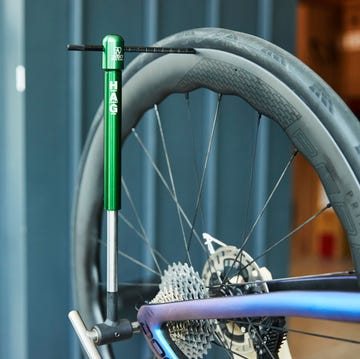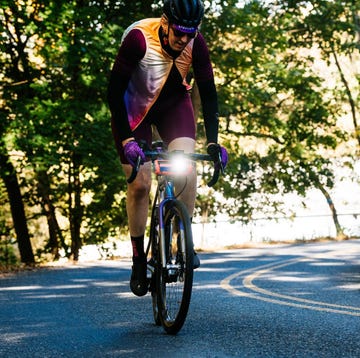Jump to:
- How to Measure Your Resting Heart Rate
- The Average Resting Heart Rate
- Factors That Influence Resting Heart Rate
- How Resting Heart Rate Affects Your Fitness, Performance, and Health
- The Benefits of Improving Your Resting Heart Rate
- How to Improve Your Resting Heart Rate
- When to Be Concerned About Changes in Resting Heart Rate
Of all the metrics that wearables track, resting heart rate (RHR) is an easy one to gloss over. It’s not as sexy as VO2 max, widely considered one of the best measures of cardio fitness. Nor is it as empowering as miles pedaled, feet climbed, or calories burned.
But there’s a lot of intel you can glean from resting heart rate and some pretty compelling reasons to keep regular tabs on it, whether you’re a serious cyclist or a casual rider.
We tapped two experts for a deep dive on this under-appreciated stat, including what the number means, average resting heart rates across the population, factors that influence your RHR, how to lower your number, and when to check in with a doctor about changes to your RHR. Here’s all you need to know.
How to Measure Your Resting Heart Rate
Resting heart rate is the number of times your heart beats per minute while you’re, well, resting, Heather Hart, C.S.C.S., South Carolina–based certified cycling coach and founder of Hart Strength and Endurance Coaching, tells Bicycling.
Resting is the key word here, with the most accurate measure of RHR being first thing in the morning right when you wake up and are still lying down, Fabio Comana, M.A., M.S., faculty lecturer at San Diego State University, tells Bicycling. Standing up, he explains, can significantly spike your heart rate.
Many wearable devices track RHR, though the accuracy of these readings can vary, especially if they’re measuring it while you’re not at true rest.
For a more reliable figure, try the old fashioned method: Find a pulse on your wrist or neck, count the beats for 30 seconds, and multiply that number by two.
A few tips to get an extra accurate reading: If you’re measuring via the wrist, use your index, middle finger, or both to find your radial pulse, which is on the outside middle part of your wrist, closer to the thumb side. Relax your arm in front of you—don’t raise it overhead, as that could lower your heart rate—and apply some gentle pressure to feel the pulse, Comana says.
If you’re monitoring your neck, make sure you’re not applying too much pressure with your fingers, as that can stimulate your vagus nerve (a cranial nerve that carries signals between your brain, heart, and digestive system) and activate your parasympathetic system (the state of rest and repair), thus lowering your heart rate, Comana explains.
Last thing: When you’re counting, technically, the first beat you feel is zero and the subsequent beat is one, as that signifies the completion of a single cardiac cycle, Comana explains.
The Average Resting Heart Rate
Once you’ve peeped your resting heart rate, it’s only natural to be curious how your number stacks up to other folks.
First though, let’s define both ends of the spectrum: A RHR lower than 60 beats per minute is classified as bradycardia (a scientific term for a slow heart rate), whereas one that’s above 100 is characterized as tachycardia (scientific term for fast heart rate). By that logic, anything between 60 to 100 is “normal,” Comana says.
But in reality, the majority of the healthy population falls into the range of low 60s to low 80s, he says. In fact, a RHR in the 90s, though technically not tachycardia, would be somewhat concerning, Comana says.
On the other end of the spectrum, it’s completely normal for active individuals, like cyclists, to have a RHR below 60. For endurance athletes specifically, RHR can range from the high 40s to 60s, says Hart, and even dip as low as the 30s, though “that’s a little more rare,” she says.
Is there such a thing as too low? Typically, no. As long as you have a strong heartbeat, normal blood pressure, and you’re not showing signs of circulation issues—such as your lips turning blue, lightheadedness, or numbness in your feet—there’s not really concern about how low your resting heart rate goes, Comana says.
Factors That Influence Resting Heart Rate
Anyone who’s started or stopped a consistent fitness routine may have noticed that exercise can definitely influence your resting heart rate. Specifically, working out on the regular can help your cardiovascular system become more efficient and thus cause your RHR to gradually decrease. Research backs this up, supporting that idea that endurance training and yoga in particular can significantly lower RHR.
The opposite happens when you pause an exercise routine: Your RHR will gradually tick up as you lose cardiovascular fitness. But there’s some nuance here, as more exercise isn’t always better. In fact, working out too much can also cause your RHR to climb, Comana says, because your body’s overstressed. That’s why it’s important to balance tough workouts with adequate recovery.
Exercise habits aside, there are a bunch of other factors that play into RHR, too. Genetics are perhaps the most influential. Some people have a naturally low heart rate, and it doesn’t necessarily mean they’re more fit, Comana explains. “It’s just their genetic variants,” he says.
Age and gender also weigh in. As the years tick by, RHR tends to increase slightly due to naturally occuring physiological processes. “The heart is just like a vehicle,” Comana explains. “As it gets older, it does suffer some losses, some attrition.”
On the gender front, women typically have a slightly higher RHR than men, Comana says. The average adult man has a heart rate between 70 and 72 beats per minute (bpm), while the average adult woman’s is between 78 and 82, according to a 2014 review published in the Journal of Clinical and Diagnostic Research. (This is general heart beat, not just resting.)
This difference is mostly explained by the fact that women have smaller hearts that pump less blood with each beat, which means they have to beat at a faster pace to match the work of a man’s larger heart, the researchers explain.
On a day-to-day basis, factors including elevated stress, lack of sleep, increased caffeine intake, dehydration, and certain medications can all cause your RHR to trend upward.
How Resting Heart Rate Affects Your Fitness, Performance, and Health
Because a lower resting heart rate can signify a more efficient cardiovascular system, it makes sense to assume that someone with a lower rate would perform better on the bike than a similar athlete with a higher number.
But it’s more complex than that. “Resting heart rate might not be indicative of other things that are important for performance,” Hart says, like biomechanics and lactate clearing abilities.
As Hart explains it: “A lower resting heart rate is probably a good indicator that you’re fit and you’re an athlete, but it’s not the one thing that says, okay, you’re gonna win the race because of your resting heart rate.”
Comana agrees that while resting heart rate is not a bad measure of an athlete’s overall functional capacity, recovery heart rate—also known as cardio recovery rate, a measure of how quickly your heart rate drops after intense exercise—is the “holy grail” of assessing someone’s fitness level.
RHR, instead, is important when looking at overall health and longevity, Hart says. Why’s that? Well, “the heart is a muscle, and it can wear out like anything else,” she says. And the less it works during times of rest—the lower resting heart rate you have—the better chance you have at a longer life, Hart explains.
Indeed, according to research, a lower RHR is associated with a lower risk of dying from any cause. On the flip side, a higher RHR is correlated with increased chances of high blood pressure and elevated risk of cardiovascular disease.
That said, “the quintessential marker of longevity,” Comana says, is VO2 max. That’s because it’s the overall measure of how well your heart functions, he explains.
The Benefits of Improving Your Resting Heart Rate
Making the effort to lower your RHR can yield big benefits. “First of all, it’s a healthier cardiovascular system,” Comana says.
Generally speaking, a lower RHR signals that you’re managing stress well and spending more time under the influence of the parasympathetic nervous system (the “rest and digest” state) versus the sympathetic nervous system (“fight or flight” mode), Comana says. That’s a good thing, considering spending too long in the sympathetic mode can strain your body, according to the Cleveland Clinic.
Plus, a lower heart rate, like we mentioned, is linked with boosted longevity. In a 16-year-long study involving 2,798 middle aged men, published in 2013, researchers found that mortality risk was lowest among men with the lowest RHRs and that risk increased as RHR climbed.
Those who had a RHR between 81 to 90 bpm were twice as likely to die compared to men with RHR below 50 bpm, and men with a RHR above 90 bpm were three times as likely. The researchers concluded a higher RHR is a risk factor for mortality independent of someone’s fitness level, general physical activity habits, and other major cardiovascular risk factors.
How to Improve Your Resting Heart Rate
Maintaining a regular exercise routine is a surefire way to improve your resting heart rate. You won’t see a difference overnight, but you should notice the impact within several weeks to months, Comana says.
So if you’re not in the habit already, Hart suggests meeting the current Physical Activity Guidelines for Americans, which recommend 150 minutes of moderate-intensity exercise, or 75 minutes of vigorous exercise, each week. Consider those the bare minimum benchmarks, and ideally try to do a little more, Hart says.
Of course, like we mentioned, too much exercise can have the opposite effect—spiking your resting heart rate within as little as a week, according to Comana—so make sure you’re giving your body enough downtime in between workouts to recover.
Beyond that, do what you can to manage stressors in your life, because stress can have a “huge impact” on RHR, Comana says, describing it as an “undervalued” factor.
We get it: This is way easier said than done, but tools like deep breathing and meditation can help. From there, prioritize adequate, quality sleep; stay on top of your hydration; eat a nutritious diet; limit caffeine intake; and curb any smoking habits. Basically, do your best to live a healthy life. It’s not rocket science, but it is effective.
And if, after putting in the work, you’re not seeing the changes you're hoping for? “Absolutely reach out to a physician,” Hart says.
When to Be Concerned About Changes in Resting Heart Rate
Because resting heart rate is affected by so many factors—some within your control and others beyond it—it’s common to sometimes see fluctuations in the numbers. But how can you know the difference between NBD shifts and worrisome swings?
For starters, Comana suggests looking not at one-time measures (say, a change from Monday to Tuesday), but instead for patterns over time. He advises getting into the habit of measuring your RHR every two days and noting any changes that happen over the course of a week to 10 days.
Say, for example, your normal RHR is 64, but over a seven-day span, it’s climbed to 74. With that change, you don’t need to run to the doctor, Comana says. Instead, take stock of what’s going on in your life. Do you have more stress than usual? Has your sleep been wonky? Are you slacking on hydration?
“I always tell people to stop, evaluate, examine what’s going on,” Comana says. Look for factors you can control yourself and make tweaks accordingly, whether that’s starting a meditation practice, prioritizing an earlier bedtime, or sipping more H2O throughout the day.
From there, if your RHR is still elevated, you may be overtraining, in which case Comana recommends taking a few days off from hard workouts and instead focusing on recovery, employing tools like gentle stretching, mindful breathing, adequate hydration, and quality nutrition. Hopefully, that’ll help your number return to baseline.
But if you’ve tried these measures and your RHR is still jacked? That’s when you might want to check in with your doctor, Comana says.

Jenny is a health and fitness journalist. She’s also an NASM-certified personal trainer. Her work has been published by Vogue, Glamour, SELF, Outside, and Health, among others. She lives in Colorado, where she teaches water aerobics at her local rec center.













